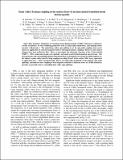Files in this item
Giant valley-Zeeman coupling in the surface layer of an intercalated transition metal dichalcogenide
Item metadata
| dc.contributor.author | Edwards, Brendan | |
| dc.contributor.author | Dowinton, O | |
| dc.contributor.author | Hall, A | |
| dc.contributor.author | Murgatroyd, Philip | |
| dc.contributor.author | Buchberger, Sebastian | |
| dc.contributor.author | Antonelli, Tommaso | |
| dc.contributor.author | Siemann, Gesa-Roxanne | |
| dc.contributor.author | Rajan, Akhil | |
| dc.contributor.author | Abarca Morales, Edgar | |
| dc.contributor.author | Zivanovic, Andela | |
| dc.contributor.author | Bigi, Chiara | |
| dc.contributor.author | Belosludov, R | |
| dc.contributor.author | Polley, M | |
| dc.contributor.author | Carbone, D | |
| dc.contributor.author | Mayoh, D | |
| dc.contributor.author | Balakrishnan, G | |
| dc.contributor.author | Bahramy, M | |
| dc.contributor.author | King, Phil | |
| dc.date.accessioned | 2023-01-20T10:30:08Z | |
| dc.date.available | 2023-01-20T10:30:08Z | |
| dc.date.issued | 2023-04-01 | |
| dc.identifier | 282908534 | |
| dc.identifier | f169ba32-51d9-4135-88a0-3eb2457188d8 | |
| dc.identifier | 85146538282 | |
| dc.identifier | 000916011400001 | |
| dc.identifier.citation | Edwards , B , Dowinton , O , Hall , A , Murgatroyd , P , Buchberger , S , Antonelli , T , Siemann , G-R , Rajan , A , Abarca Morales , E , Zivanovic , A , Bigi , C , Belosludov , R , Polley , M , Carbone , D , Mayoh , D , Balakrishnan , G , Bahramy , M & King , P 2023 , ' Giant valley-Zeeman coupling in the surface layer of an intercalated transition metal dichalcogenide ' , Nature Materials , vol. 22 , no. 4 , pp. 459-465 . https://doi.org/10.1038/s41563-022-01459-z | en |
| dc.identifier.issn | 1476-1122 | |
| dc.identifier.other | ORCID: /0000-0003-0029-5059/work/127066251 | |
| dc.identifier.other | ORCID: /0000-0003-0015-0220/work/127066271 | |
| dc.identifier.other | ORCID: /0000-0001-5356-3032/work/127066339 | |
| dc.identifier.other | ORCID: /0000-0002-7219-4241/work/151190654 | |
| dc.identifier.uri | https://hdl.handle.net/10023/26790 | |
| dc.description | Funding: The authors gratefully acknowledge support from the Leverhulme Trust (Grant No. RL-2016-006 [P.D.C.K., B.E., T.A., A.R., C.B.]), the European Research Council (through the QUESTDO project, 714193 [P.D.C.K., G.R.S.]), the Engineering and Physical Sciences Research Council (Grant Nos. EP/T02108X/1 [P.D.C.K., P.A.E.M.] and EP/N032128/1 [D.A.M., G.B.]), and the Center for Computational Materials Science at the Institute for Materials Research for allocations on the MASAMUNE-IMR supercomputer system (Project No. 202112-SCKXX-0510 [R.B.V., M.S.B.]). S.B., E.A.M. and A.Z. gratefully acknowledge studentship support from the International Max-Planck Research School for Chemistry and Physics of Quantum Materials. Research conducted at MAX IV, a Swedish national user facility, is supported by the Swedish Research council under contract 2018-07152, the Swedish Governmental Agency for Innovation Systems under contract 2018-04969, and Formas under contract 2019-02496. The research leading to this result has been supported by the project CALIPSOplus under the Grant Agreement 730872 from the EU Framework Programme for Research and Innovation HORIZON 2020. | en |
| dc.description.abstract | Spin–valley locking is ubiquitous among transition metal dichalcogenides with local or global inversion asymmetry, in turn stabilizing properties such as Ising superconductivity, and opening routes towards ‘valleytronics’. The underlying valley–spin splitting is set by spin–orbit coupling but can be tuned via the application of external magnetic fields or through proximity coupling. However, only modest changes have been realized to date. Here, we investigate the electronic structure of the V-intercalated transition metal dichalcogenide V1/3NbS2 using microscopic-area spatially resolved and angle-resolved photoemission spectroscopy. Our measurements and corresponding density functional theory calculations reveal that the bulk magnetic order induces a giant valley-selective Ising coupling exceeding 50 meV in the surface NbS2 layer, equivalent to application of a ~250 T magnetic field. This energy scale is of comparable magnitude to the intrinsic spin–orbit splittings, and indicates how coupling of local magnetic moments to itinerant states of a transition metal dichalcogenide monolayer provides a powerful route to controlling their valley–spin splittings. | |
| dc.format.extent | 7 | |
| dc.format.extent | 4455338 | |
| dc.language.iso | eng | |
| dc.relation.ispartof | Nature Materials | en |
| dc.subject | QC Physics | en |
| dc.subject | TK Electrical engineering. Electronics Nuclear engineering | en |
| dc.subject | DAS | en |
| dc.subject | MCC | en |
| dc.subject.lcc | QC | en |
| dc.subject.lcc | TK | en |
| dc.title | Giant valley-Zeeman coupling in the surface layer of an intercalated transition metal dichalcogenide | en |
| dc.type | Journal article | en |
| dc.contributor.sponsor | The Leverhulme Trust | en |
| dc.contributor.sponsor | European Research Council | en |
| dc.contributor.sponsor | EPSRC | en |
| dc.contributor.institution | University of St Andrews. School of Physics and Astronomy | en |
| dc.contributor.institution | University of St Andrews. Centre for Designer Quantum Materials | en |
| dc.contributor.institution | University of St Andrews. Condensed Matter Physics | en |
| dc.identifier.doi | 10.1038/s41563-022-01459-z | |
| dc.description.status | Peer reviewed | en |
| dc.identifier.grantnumber | 2016-006 | en |
| dc.identifier.grantnumber | 714193 | en |
| dc.identifier.grantnumber | EP/T02108X/1 | en |
This item appears in the following Collection(s)
Items in the St Andrews Research Repository are protected by copyright, with all rights reserved, unless otherwise indicated.

